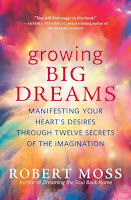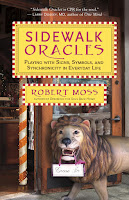The word “synchronicity” was coined by Jung to flag patterns
of meaningful coincidence. He defined
“synchronicity” as “the coincidence in time of two or more causally unrelated
events which have the same meaning”, the work of “an acausal connecting
principle.”
Things come up at
the same time, or in a certain sequence, that feel as if they are closely
connected, but cannot be attributed to any linear sequence of cause and event.
Dreams and waking events may interweave closely, and may have the same quality.
Coincidence is at work, but it cannot be shrugged off as “mere” coincidence.
Synchronicities mean something.
Sometimes they nudge us towards the perception of a deeper meaning in our lives
than our everyday habits and attitudes have made room for. They can feed that
hunger for meaning that is a defining characteristic of any human who is truly
alive. They move us beyond our tendency to put fences around possibility.
Benign synchronicities
tend to come thick and fast at times of change, moments that stir the soul,
when our passions are aroused – when we fall in love, or make a leap of faith,
or are embarking on a new creative endeavor, or are close to birth or death.
Benign synchronicity may provide powerful confirmation of a path we are testing
– or open a path of which we were previously unaware. Synchronicities can
strengthen us in the determination to follow our deepest intuitions even when
they run counter to conventional wisdom and logic and cannot be subjected to
rational explanation. Like the exchange of secret handshakes between members of
a secret fraternity, these signals alert us to the fact that we are not alone,
that we have invisible sources of support, and that we are on the right course
even when the whole world seems to be going the other way.
Negative
synchronicities and counter-currents tend to multiply when we are resisting
change, or insisting on following an ego-driven agenda.
Synchronicities
carry us beyond stolid distinctions between inner and outer, mind and matter.
They may arouse the suspicion that, when we are most deeply alive, we somehow
call up from the depths of soul the events and situations that are played out
around us.
Synchronicity
helps us awaken to the fact that beyond the surface of things, everything is
alive, animate, conscious. By making it our game to enter actively into the
play of synchronicity, we move towards conscious engagement with the powers of
the deeper world.
Synchronicity is
the grammar of epiphany. An epiphany is literally a “showing forth”. The
epiphanies of life, those numinous “show times” when we glimpse the deeper
reality behind the manifest world, and derive insight into the larger meaning
of our personal existence, come with the intersection of a hidden order of
events with our seemingly linear progression through space/time.
The play of
synchronicity helps us to move into a creative flow state, and invites us to
step outside linear time and history into kairos
time, the “jump time” of creative opportunity.
As English
physicist F. David Peat writes lyrically in Synchronicity: The Bridge between Matter and Mind. , through synchronicity, as well as
peak experiences, “creativity breaks through the barriers of the self and
allows awareness to flood through the whole domain of consciousness. It is the
human mind operating, for a moment, in its true order and extending throughout
society and nature, moving through orders of increasing subtlety, reaching past
the source of mind and matter into creativity itself.”
A conscious
engagement with synchronicity, like a conscious relationship with the
dreamworlds, enables us to connect with a multidimensional perspective and
become co-creators of what is manifested from a deeper reality in our physical
worlds.
Dreaming and synchronicity are the warp and woof of our experience of
a deeper reality. In dreaming, we go there. Through synchronicity, the forces
of that deeper world leave their mark on our surface world and give us a spur
to live juicier, more magical lives.
Wolfgang Pauli, the pioneer of quantum physics who helped
Jung develop his theory of synchronicity, did not like the term, which
literally speaks only about things happening at the same time. Pauli suggested
“isomorphy”, a term that in mathematics refers to identity or near-identity of
form, and this is a useful word since connection by resemblance is arguably a
more significant element in meaningful coincidence than convergence at a single
moment in time. Indeed, we may experience a series of coincidence over a
considerable period of time, a situation I have called reincidence. However, “synchronicity” has entered the household
vocabulary and sounds scientific and so we are stuck with it.
I decided that we need a new term to
describe the practice of navigating by synchronicity, and so I invented one: kairomancy. The first part incorporates
the name of a Greek god of time very different from Chronos, the lord of
tick-tock linear time. Kairos is the god of special moments, the god of jump
time or opportunity time, when time operates quite differently. You may feel
that time has stopped or that something from outside time is coming into play.
Kairos is depicted as a fleet young man, hairless except for a lock of hair
falling over his forelock. From this image we get the phrase, “Seize time by
the forelock.” Kairos embodies the moment of opportunity you do not want to let
slip.
Hence, kairomancy, literally, “divination by special moments”. Develop this practice and you become a
kairomancer, someone who is always poised to recognize and act in those special
Kairos moments of opportunity.
Text partly adapted from Sidewalk Oracles: Playing with Signs, Symbols and Synchronicity in Everyday Life by Robert Moss. Published by New World Library














